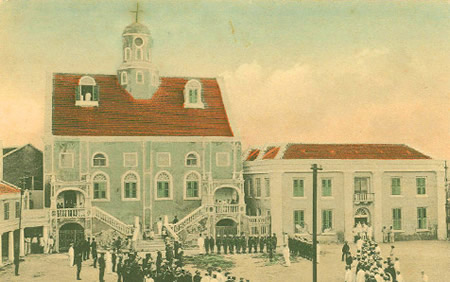 |
Photograph - Soublette et Fils, Hof-Photografen 1910 -1915 |
Summary |
 Fort Amsterdam Located on the east side of the Saint Anna Bay in Willemstad, these fortifications date back to 1635. Strategically located, the fort overlooks the entry into the harbour and protects the city. |
The fort contained wooden structures like the garrison's church, dwellings of the troops, warehouses and water reservoirs. Fort Amsterdam was a heavily armed fortification with 13 guns, of which four were heavy, in the southwestern bastion. The heavy and gently sloping exterior walls are around 3.2 meters high and the ramparts built atop these have embrasures that are narrow crevices for firing purpose. This fort has been an active part of the island’s history from its construction to the English occupation that lasted until 1816. Later, however, the fort lost its defensive significance through the construction of the Waterfort. |
Fortkerk| Fortchurch Also located within Fort Amsterdam in the capital city of Willemstad, the Fortkerk dates back to 1769, and features former warehouses under the Church and a Museum. It has sturdy walls that were built to withstand any attack, and the evidence below explains it did. (A cannonball imbedded in an exterior wall has been left as a reminder of the attack by the British in 1804 when the Fort was shelled. Local legend has it that the cannonball was fired from Captain Bligh's infamous Bounty). |
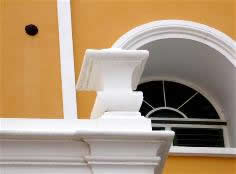 |
History |
In 1635, following the takeover of Curaçao from the Spanish and the British by the Dutch West Indies Company, the new Governor Van Wallbeeck arranged for the arrival of the first preacher on the island, Ds. Fredericus Vitteus. At the time, Curaçao was a military colony, and Ds. Vitteus was, understandably, a garrison preacher. From these beginnings, the Reformed Church of the Antilles was formed, later named the 'Hervormde Kerk', and from which the origins of the United Protestant Church of Curaçao sprung in 1824. In the Western Hemisphere, only the Reformed Church of New York, (at that time 'Nieuw Amsterdam'), established in 1624 was older. |
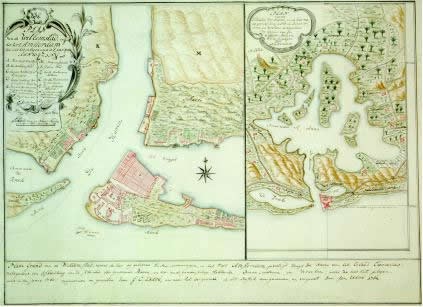 |
Old maps indicate that, as early as 1707, a small church was present in Fort Amsterdam, at the entrance of Curaçao's natural harbour. Certainly, in 1742, one existed with a similarly monumental sweep of stairs to those seen today, but it is likely the first meetings of the United Protestant Church of Curaçao were held in a storage room of the Fort. |
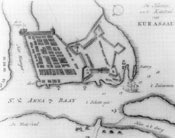 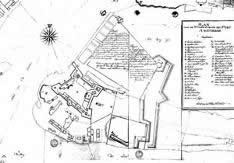 |
Given the ongoing possibility of lengthy sieges, it was necessary to build rainwater reserves within the Fort, and one of these cisterns, dating back to 1742, still exists behind the stair door to the Museum, which from 1821 formed the old vestry. The back door of the museum leads to 'Parapet the Cat', where a cannon was previously situated. |
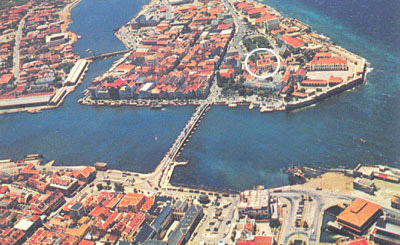 |
The present-day Fortchurch in historic Fort Amsterdam is the oldest church still in daily use on Curaçao. Construction took place between 1767 and 1771 and the facade bears the date 1769. It is known that the construction cost 5,500 pesos (approximately 11,000 guilders), but nothing is known of the architect (although both Hendrik de Hamer and Frederik Staal were closely involved in the work). The vicarage stood next to the church on the spot that is currently the seat of the Government. |
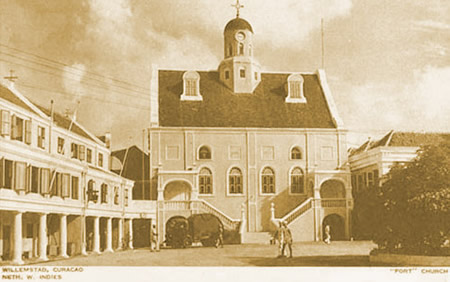 |
The Fortchurch is not large, (20.5 X 13.25 m), but is particularly high, with the tallest point of the tower reaching 16 meters above ground level. Given the small area of space available within the Fort, careful planning had to be done for the way it would be used. The high ceilings also doubled as an effective area in which to dry and store ship sails, which were hoisted up by pulley. |
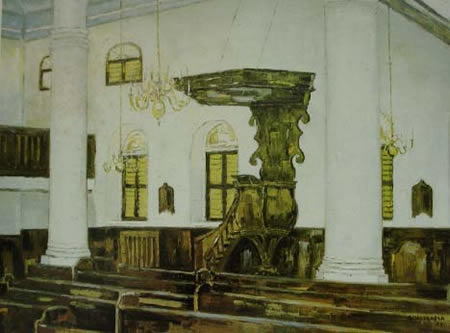 |
Tower |
The original tower of the Church was octagonal and was replaced by a round one in 1903, (which is clearly marked on the facade), designed by Mr. A.W. Statius Muller, the Head of the Building Department. |
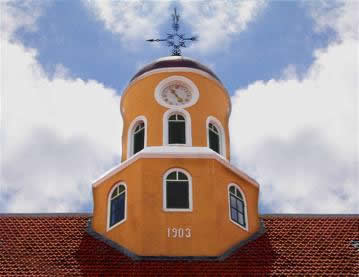 |
Clockwork |
The original clockwork in the tower dates from 1788 and was a gift from Captain Dirk van der Meer. During the extensive restoration of the church in 1991, this clock and its five dials in the tower and ceiling were overhauled by Mr. Henk W. Vos van Zalingen. |
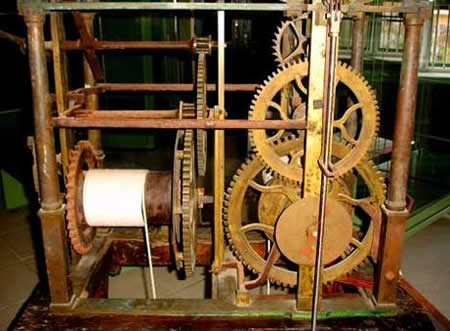 |
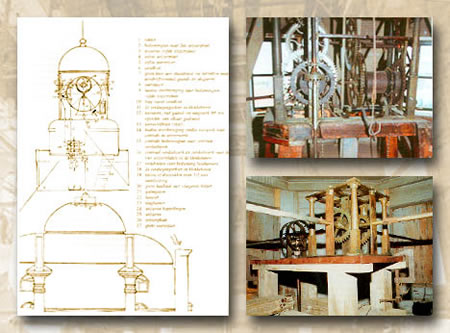 |
However, the intricate mechanical clockwork was particularly expensive to maintain, and in 1994, a new computerized clockwork was obtained from Japan. The original mechanical workings are on exhibit in the Museum, these being the only two such examples in the entire world. More information about the clockwork and the extensive restoration of the Fortchurch are detailed in a booklet written by Bart Bredero entitled 'De Fortkerk te Willemstad Curaçao, 1990-1992', and is available for purchase in the Museum. |
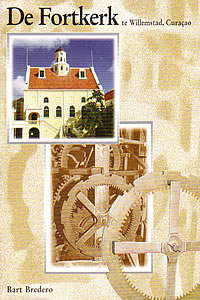 |
Organ |
The Precentor-Sexton Hendrik van Hulst originally designed an organ with ten registers, but in 1785 - at least in the eyes of Ds. Rudolf Widrik - this was too small and he enlarged it by a further four registers. The organ now in use dates from 1963 and was totally restored in 2000. This organ has breastwork, backwork and two manuals, a foot pedal and 17 registers. It was built by Flentrop Orgelbouw N.V. Zaandam, in the Netherlands. |
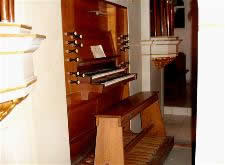 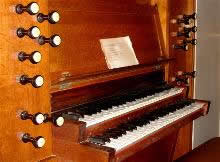 |
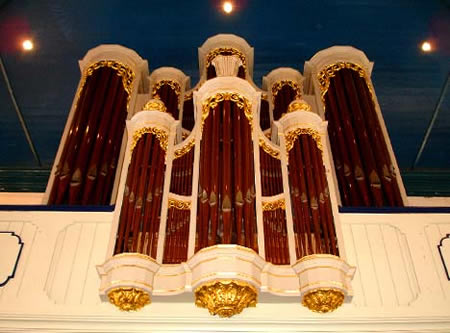 |
Renovation |
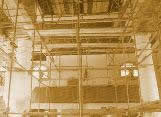 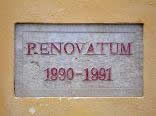 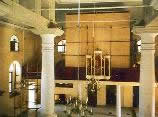 |
After various renovations done in earlier years, the Church finally closed due to significant deterioration in late 1988. On February 1st, 1990, a massive restoration project began. |
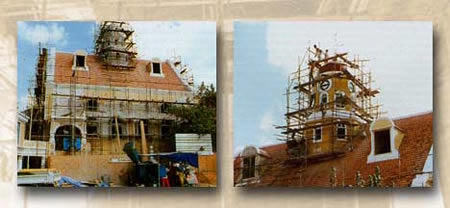 |
The total cost of this restoration work amounted to some 2.5 million Antillian Guilders, of which 600,000 NAfl was raised locally by church members and other parties in Curaçao. The remainder was paid by the 'Meerjarenplan Nederlandse Antillen' - an aid plan financed by the Kingdom of the Netherlands. |
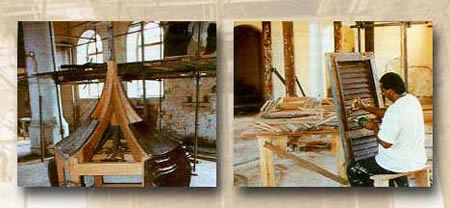 |
Many improvements were made during the course of this major undertaking, including those to the cellars, mentioned earlier. The vestry was also transformed into a Museum detailing the history and culture of Protestantism in Curaçao from 1643. Four vitrines were donated by the Prins Bernhard Cultural Fund and divided into the following sections: |
|
Cellars |
The cellars underneath the church were used as storage for provisions, ammunition, food, and - up to 1930 - also for spirits. During the restoration, these cellars were redesigned and were converted into offices for Church administration, meetings rooms and a nursery. |
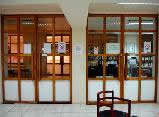 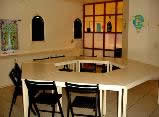 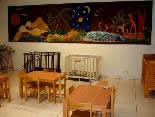 |
The Church Today |
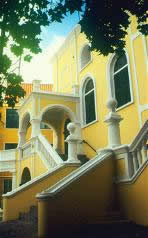 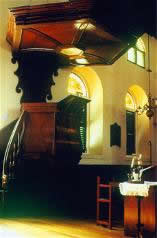 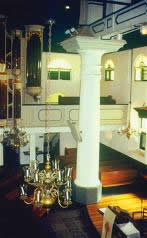 |
Photographs above by Eliane Muskus |
On October 27th, 1991, the Church re-opened with great festivity. Within the Church, the pulpit (above center, and below) and the Governor's pew (also below) are the oldest and most striking pieces of furniture, both made of mahogany, a very hard wood which is well protected from the ravages of termites. The pulpit was fashioned after the Dutch model. It consisted of a curved basin in Rococo style with a back panel. |
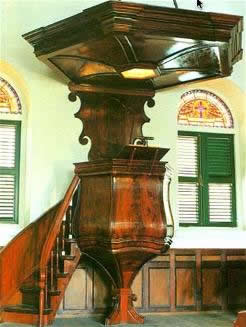 |
Photos (above and below left)from the book "Furniture from Curacao, Aruba and Bonaire by Georgette E. Nije-Statius van Eps |
The pulpit (above) and Governor's pew (below) demonstrate a degree of craftmanship which was to reach its peak over the next twenty years. These masterpieces of joinery date from 1769 and were crafted by the Deacon and master carpenter Pieter de Mey (grandson of the Pieter de Mey for whom the quarter 'Pietermaai' was named). They date from an earlier renovation of the Church. The island was prospering, and because it was deemed there were no poor people in the community at that time, the renovation was financed out of the Church's poor relief fund. |
 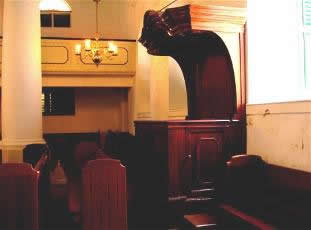 |
The pews (pictured with the Governor's pew above) in the church were manufactured by the C.F. Muskus Company. They originally imported furniture from the Netherlands, but during the Second World War, When imports stagnated, they started producing their own furniture on Curaçao. The factory was in Penstraat, east of Pietermaai. It got its mahogany from Venezuela, and the furntiture makers were also from that country. But in the end it proved to be too expensive for the local market. After the war, they soon stopped making their own furniture. The company did produce fine mahogany pews for the Fortchurch. When the Church was restored in 1991, most of the pews were cut in two to accommodate them in the new layout. The Muskus family donated half of the pews to the Fortchurch. |
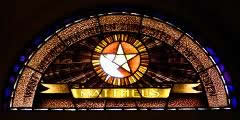 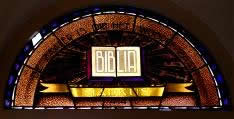 |
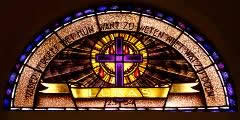 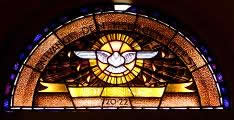 |
Shortly after WWII, the stained-glass windows were installed. In the west wall, four presentations and text from the Old Testament may be seen. And in the east wall, the presenations depict the Four Evangelists. |
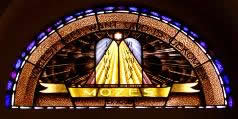 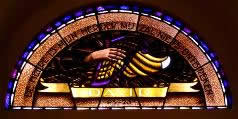 |
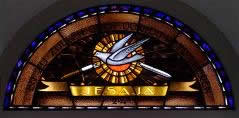 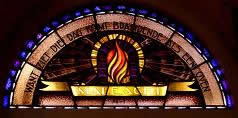 |
Two smaller windows, also in the east wall, represent incidents from local Church history. |
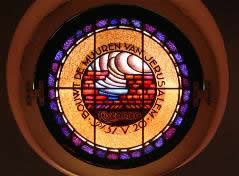 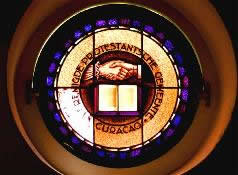 |
Sunday morning services begin at 9:30. Wedding services are also held at the Church, and because of the excellent acoustics, The Cultural Committee Fortchurch organizes classical and popular music concerts and other cultural events featuring local and international artists. Information on upcoming events can be obtained from the Fortchurch
Office by telephone (+5999 461-1139) |
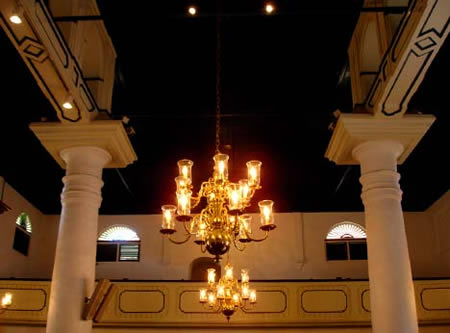 |
Any funds raised by the CCF are used for ongoing maintenance of this monumental Church in Fort Amsterdam that is the center of the UNESCO World Heritage Site of Willemstad, which is the capital city of the island of Curaçao in the Netherlands Antilles. |
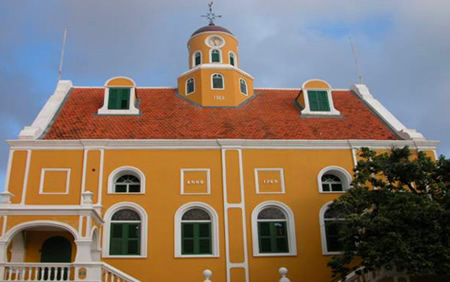 |


